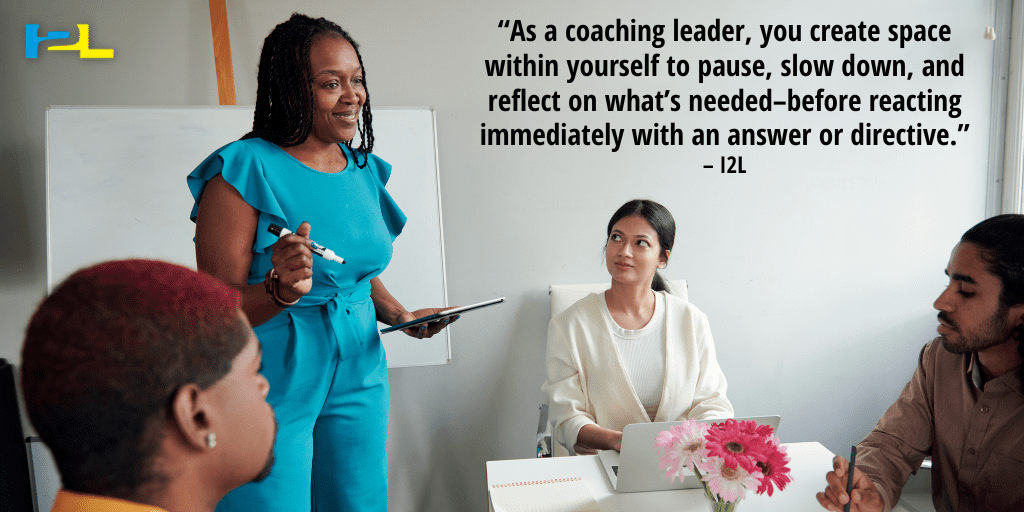Accountants are busy.
And if you’re a leader in your firm, you may feel like you need to have all the answers all the time, your plate is always full, and you’re moving from one task to the next as quickly as possible (even though you never quite get everything crossed off your list!). Your team continually comes to you with questions, and you feel pressured to have a definitive response at the ready.
What if we told you there’s a solution that gives you back your time and mental energy, while helping your team perform with more autonomy, creativity, and ownership?
That solution is cultivating coaching as a leadership style.
Two of the biggest leadership challenges in accounting are:
- Engaging teammates, colleagues, and staff in a way that cultivates ownership of and accountability for their ideas and actions.
- Creating connection, partnership, and belonging within your team.
By embracing coaching as a leadership style, you can tackle both of these challenges and cultivate an environment of belonging that invites more ownership from your team.
Shift Your Role
Coaching as a leadership style encompasses two things:
- How you engage with others as a leader.
- How you engage with yourself.
When you choose to put on your coaching hat, you move from being a mentor or an advice-giver to a facilitator; helping yourself and others navigate the unknown, collaborate, and uncover new solutions and possibilities.
It’s a practice of partnering with each individual (yourself included), in a thought-provoking and creative process that inspires the maximization of personal and professional potential.
The Coaching Mindset
Implementing a coaching leadership style begins with a mindset shift. Once you start seeing challenges and opportunities through a coaching lens, you can choose which interactions call for coaching and which could benefit from clear directives.
Coaching may not be what someone needs from you in every moment, but leading with a coaching mindset cultivates self-awareness and the ability to pause, check-in, and ask yourself some informative internal questions before acting or reacting:
- What do I need and want in this situation?
- How do I want to show up in this moment?
- How could I be a vehicle for change?
Next, you can ask yourself these external questions:
- What does this person need from me right now?
- How could I best support this person’s development?
- What does this situation or challenge require of me?
What best serves the other person could be coaching, mentoring, or providing feedback. Or, in some cases, it could be giving them an explicit answer or directive.
As a coaching leader, you’ll create space within yourself to pause, slow down, and reflect on what’s needed–before reacting immediately with an answer or directive.
We’ve worked in the accounting space for many years and have seen that cultivating coaching as a leadership style can pose challenges within a profession that historically prides itself on speed, expertise, and having the right answers immediately. With support, tools, and conscious intention, leaders can shift into this more counter-intuitive practice of not always giving answers immediately, which creates more experiences of support, empowerment, engagement, and possibility within their teams.
Create Choice
Coaching as a leadership style invites openness and spaciousness, which creates choice–and therefore ownership and accountability. For leaders who hold a deep belief in the talents and resourcefulness of their team and are committed to helping each individual unlock their unique potential, this style uncovers new possibilities – what we call the Dimension of Possible.
The coaching leader is self-reflective and willing to ask hard questions of themselves and others. They understand that when they don’t have all the answers all the time, they are constantly learning and growing as a leader. By asking questions first, they create more possibilities–for themselves, their team, and their organization.
What do you need to practice a coaching leadership style?
- Courage to be uncomfortable with ambiguity and the unknown.
- Willingness to embrace the power of questions and let go of having to know all the answers.
- Curiosity about yourself, others, challenges, and what’s possible.
- A practice of asking instead of telling. This empowers others to become more resourceful and gives them space to learn and develop (instead of relying on you).
- Trust in yourself and the other person. This allows you both to slow down and sit in the struggle.
Sitting with the unknown, waiting, struggling, and trusting can feel like jumping off a cliff without knowing how high up you are, especially when you’re used to being an expert and knowledge provider. But there is power in embracing the unknown and inviting others to step into their own wisdom. This is the leadership our profession needs in the face of ambiguity!
Start observing yourself. When you notice a tendency to jump in and solve for others, try to W.A.I.T. (Why Am I Talking?) instead. Giving an answer is not necessarily wrong, but by asking questions instead, you create more choices for the other person (and for yourself as a leader).
Notice the thoughts you think and the statements you make about yourself and your team. Do they help the situation at hand and align with your values and your organization’s culture? Or, are they limiting statements, such as, “I don’t have time for this right now,” “They can’t figure this out without me,” or “They’ll never know as much as I do about this.”
Cultivating a coaching leadership style requires you to slow down and choose to engage, rather than dismiss. By shifting your mindset before you even go into a conversation, you can change the entire environment. You can deepen curiosity and presence in yourself and others.
Empower Resourcefulness and Ownership
You could start your coaching practice by simply responding to a team member’s question with, “What do you want in this situation?” or, “What do you think?”
Asking the question (instead of sharing your answer) shifts the dynamic, and challenges the other person to think critically. It helps them come up with their own ideas and solutions, encouraging resourcefulness and accountability.
After asking a question, you must be willing to listen and trust that the other person can come up with their own answer. You must be prepared for the possibility that their answer may be different from your own. This requires patience, trust, and humility. It will typically take longer for them to generate their own answer than for you to give them yours. You may have to revisit the conversation later after they’ve had an opportunity to reflect. Although it may feel like this approach takes longer in the moment, it will save you time in the future when your team learns to think more critically, take ownership, and come up with their own solutions.
Change exists everywhere, all the time, especially in the accounting profession. By showing up as a coaching leader, you will help your team navigate change with less friction and more grace. You’ll invite connection, trust, and collaboration, cultivating an environment of learning and growth within your team and organization
If we can help you and other leaders in your organization cultivate coaching as a leadership style, please reach out.
See you in the DOP,









